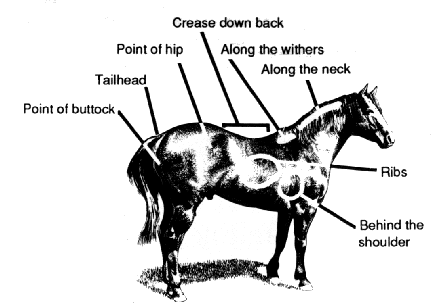
Normal Body Condition
The body condition or degree of fat cover of horses is a good indicator of their general health. Proper body condition depends a great deal on use. However, a condition scoring system designed to gauge reproductive efficiency in mares can serve as a guide to judging the health and fitness of all horses. This system is presented in the following table.
Animals with a score between 4 and 6 can be considered healthy. Scores lower than 4 or higher than 6 on this scale indicate the likelihood of metabolic and other health problems.

Score Condition Description
1 Poor. Animal extremely emaciated. Spinous processes, ribs, tailhead, and point of hip and point of buttocks project prominently; bone structure of withers, shoulders, and neck easily noticeable; no fatty tissue can be felt.
2 Very Thin. Animal emaciated. Slight fat covering over the base of spinous processes; transverse processes of the lumbar vertebrae feel rounded; spinous processes, ribs, tailhead, and point of hip and point of buttocks prominent; withers, shoulders, and neck structures faintly discernible.
3 Thin. Fat built up about halfway on the spinous processes; transverse processes cannot be felt; slight fat cover over the ribs; spinous processes and ribs easily discernible; tailhead prominent, but individual vertebrae cannot be identified visually; point of buttocks appear rounded but easily discernible; point of hip not distinguishable; withers, shoulders, and neck accentuated.
4 Moderately Thin. Slight ridge along back; faint outline of ribs discernible; tailhead prominence depends on conformation, but fat can be felt around it; point of hip not discernible; withers, shoulders, and neck not obviously thin.
5 Moderate. Back is flat (no crease or ridge); ribs not visually distinguishable but easily felt; fat around tailhead beginning to feel spongy; withers appear rounded over spinous processes; shoulders and neck blend smoothly into body.
6 Moderate to fleshy. May be slight crease down back; fat over ribs spongy; fat around tailhead soft; fat beginning to be deposited along the side of withers, behind shoulders, and along the sides of neck.
7 Fleshy. May have crease down back; individual ribs can be felt, but there is noticeable fat between ribs; fat around tailhead soft; fat deposited along withers, behind shoulders, and along neck.
8 Fat. Crease down back; difficult to feel ribs; fat around tailhead very soft; area along withers filled with fat; area behind shoulder filled with fat; noticeable thickening of neck; fat deposited along inner thighs.
9 Extremely Fat. Obvious crease down back; patchy fat appearing over ribs; bulging fat around tailhead, along withers, behind shoulders, and along neck; fat along inner thighs may cause them to rub together; flank filled with fat.
(*Adapted from Henneke, D. R., G. D. Potter, J. L. Kreider, and B. F. Yeates. Relationship between condition score, physical measurement, and body fat percentage in mares. Eq. Vet. J. 15:371-372. 1983.)
![]() Return to Questions and Answers Index
Return to Questions and Answers Index
![]() Return to the "Learning More About Horses..." page
Return to the "Learning More About Horses..." page
COPYRIGHT © 1999 BOB LEMEN, GRAND
RAPIDS, MINNESOTA. ALL RIGHTS RESERVED.
The contents of this document are not for reproduction.